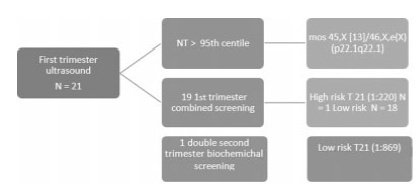Summary
Revista Brasileira de Ginecologia e Obstetrícia. 2004;26(1):45-52
DOI 10.1590/S0100-72032004000100007
PURPOSE: to evaluate the relationship between epidemiologic, anthropometric, reproductive and hormonal factors and mammographic density in postmenopausal women. METHODS: this is a retrospective, cross-sectional study, including 144 women aged 45 years or more, with at least 12 months of amenorrhea and who were non users of hormone replacement therapy during the last six months. Medical charts were reviewed to evaluate age, weight, body mass index (BMI), parity, age at menarche, age at menopause and levels of estradiol, follicle stimulating (FSH) and luteinizing hormones. Mammograms were analyzed by two blinded investigators. The films were taken in the craniocaudal and mediolateral views and mammography was classified as dense and nondense, according to the Wolfe criteria. For statistical analysis, the frequency, median, minimum and maximum values, the Wilcoxon test and the odds ratio were used. Multiple logistic regression was performed, using the stepwise selection, with a 5% significance level. RESULTS: the frequency of dense breasts was 45%. Women with dense breasts were of lower weight (60.5 vs. 71.9 kg - p<0.01), had a lower BMI (25.9 vs 31.0 kg/m² - p<0.01), a shorter time since onset of menopause (6.0 vs 10 years - p<0.01) and higher levels of FSH (75.2 vs 60.3 mU/mL - p<0.01). The probability of having dense breasts decreased in women whose weight was 67 kg or more (OR = 4.0, CI 95% = 1.50-10.66), BMI was higher than 30 kg/m² (OR = 6.69, CI 95% = 1.67-36.81), time since onset of menopause was superior or equal to seven years (OR = 2.05, CI 95% = 1.05-3.99) and FSH levels were lower than 134.8 mU/mL. CONCLUSION: weight, BMI, parity, time since menopause and FSH levels were significantly associated with mammographic density patterns.
Summary
Revista Brasileira de Ginecologia e Obstetrícia. 2003;25(1):45-52
DOI 10.1590/S0100-72032003000100007
PURPOSE: to determine maternal and neonatal outcome according to the application or not of transcutaneous electrical nerve stimulation (TENS) for relief of labor pain before installation of combined spinal epidural (CSE) block. METHODS: a randomized open clinical trial was conducted involving 22 parturients with a singleton, vertex, term fetus, managed in a tertiary-care academic medical center in Recife, Brazil. These patients were randomly assigned to receive or not TENS before CSE block for labor analgesia. Outcome analysis included pain intensity as measured by visual analog scale (VAS), interval between initial evaluation and CSE installation, labor duration, cesarian section and instrumental delivery rate, Apgar scores and frequency of neonatal hypoxia. Statistical analysis was performed using Mann-Whitney and Fisher's exact tests with a 5% level of significance. RESULTS: a significantly prolonged interval between initial evaluation and CSE block was observed in the TENS group (median of 90 min) when compared with the control group (median of 30 min). Duration of labor was similar (about 6 h). No significant difference was found in VAS scores. Cesarian section rate was 18.2% in both groups. There was only one forceps delivery (in the control group). The median of Apgar scores at the 5th minute was 10 and no case of neonatal hypoxia was found. CONCLUSONS: TENS was effective in delaying CSE analgesia installation without affecting pain intensity and duration of labor. There were no adverse effects on mothers or newborns.
Summary
Revista Brasileira de Ginecologia e Obstetrícia. 2002;24(1):45-50
DOI 10.1590/S0100-72032002000100007
Purpose: to perform a census about the frequency of endometrial adenocarcinoma of women submitted to diagnostic hysteroscopy in five Brazilian hysteroscopic centers in São Paulo, Rio de Janeiro, Salvador, Caxias do Sul and Porto Alegre. Methods: information was collected from standard questionnaires about the presence of endometrial adenocarcinoma, hysteroscopic staging and histologic type, in pre- and postmenopausal women. Results: among 6,466 hysteroscopic procedures, endometrial adenocarcinoma was present in 92 patients (1.4%), confirmed by histology in 79 (1.2%) cases. For the hysteroscopic diagnosis of endometrial adenocarcinoma confirmed by histology, a sensitivity of 85.9%, specificity of 100%, positive predictive value of 100% and negative predictive value of 98.6% were obtained. In the premenopausal group, among 3,845 hysteroscopic exams, endometrial cancer was present in 83 (3.2%) and confirmed by histology in 71 cases (2.7%). Conclusions: this study points out the importance of epidemiological methods in the diagnostic and prevention programs of endometrial cancer, specially in postmenopause, revealing the need for further epidemiological studies on endometrial adenocarcinoma diagnostis and prevention programs.
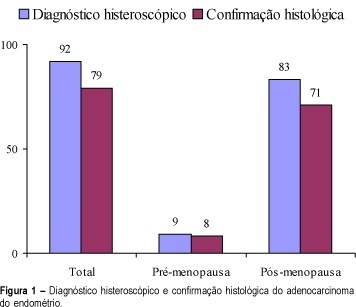
Summary
Revista Brasileira de Ginecologia e Obstetrícia. 2005;27(8):450-455
DOI 10.1590/S0100-72032005000800003
PURPOSE: to test a new, noninvasive method for the diagnosis of fetal anemia in red blood cell isoimmunized pregnancies. METHODS: the index obtained by the ratio between the ultrasonographic measurement of the biventricular outer dimension (BVOD) and femur length (both in centimeters) was correlated with fetal hemoglobin values in a cross-sectional study. Fifty-nine fetuses of isoimmunized pregnancies selected for invasive treatment and submitted to 130 cordocenteses for the diagnosis and treatment of anemia were included in the study. The cardiofemoral index was obtained immediately before the cordocentesis and the fetal hemoglobin index was obtained from fetal blood samples. Linear regression was carried out to assess the correlation between the index and fetal hemoglobin; ROC curve was applied to determine the most accurate cutoff for the diagnosis of the fetal hemoglobin concentration below 10g/dl. RESULTS: BVOD measurement varied from 1.6 to 4.7 cm (average 2.5±1.3cm), and length of the femur, from 3.0 to 6.9 cm (average 4.3±0.9 cm). The cardiofemoral index varied from 0.4 to 1.0 (average 0.6±0.1). A significant inverse correlation between the cardiofemoral index and fetal hemoglobin (R²=0.37 and p<0.0001) was observed. The cutoff of 0.60 was the best to predict a level of fetal hemoglobin below or equal to 10.0g/dl: 80.85% sensitivity, 83.13% specificity, 73.8% positive predictive value, and 88.46% negative predictive value, in the diagnosis of fetuses anemia. CONCLUSION: the cardiofemoral index allows for good accuracy in the prediction of fetal hemoglobin concentration below 10g/dl in red blood cell isoimmunized pregnancies. It may thus be applied as a noninvasive method to the diagnosis of this pathology.
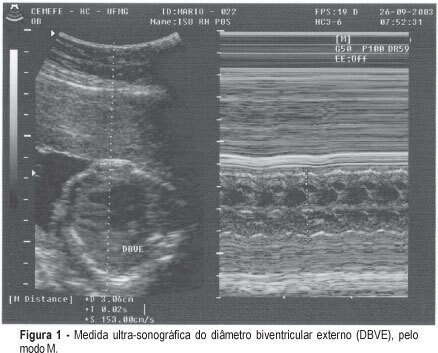
Summary
Revista Brasileira de Ginecologia e Obstetrícia. 2018;40(8):450-457
The present study aims to investigate the association between caspase-8 (CASP8) (rs13416436 and rs2037815) and Fas cell surface death receptor (FAS) (rs3740286 and rs4064) polymorphisms with endometriosis in Brazilian women.
In the present case-control study, 45 women with a diagnosis of endometriosis and 78 normal healthy women as a control group were included. The genotyping was determined by real-time polymerase chain reaction (PCR) with Taqman hydrolysis probes (Thermo Fisher Scientific, Darmstadt, Germany). Genotypic and allelic frequencies were analyzed using Chi-squared (χ2) test. In order to determine the inheritance models and haplotypes ,SNPStats (Institut Català d’Oncologia, Barcelona, Spain) was used. Levels of 5% (p = 0.05) were considered statistically significant.
No significant difference was observed in genotypic or allelic frequencies between control and endometriosis groups for rs13416436 and rs2037815 (CASP8 gene). On the other hand, a significant difference between rs3740286 and rs4064 (FAS gene) was found. Regarding polymorphisms in the FAS gene, a statistically significant differencewas found in co-dominant and dominantmodels. Only the haplotype containing the rs3740286A and rs4064G alleles in the FAS gene were statistically significant.
The polymorphisms in the CASP8 gene were not associated with endometriosis. The results indicate an association between FAS gene polymorphisms and the risk of developing endometriosis.
Summary
Revista Brasileira de Ginecologia e Obstetrícia. 2016;38(9):450-455
To demonstrate the initial experience of robotic hysterectomy to treat benign uterine disease at a university hospital in Brazil.
A cross-sectional study was conducted to review data from the first twenty patients undergoing robotic hysterectomy at our hospital. The surgeries were performed from November 2013 to August 2014, all of them by the same surgeon. The patients were reviewed for preoperative characteristics, including age, body mass index (BMI), indications for the hysterectomy and previous surgeries. Data of operative times, complications, postoperative pain and length of hospital stay were also collected.
The total operating room time was 252.9 minutes, while the operative time was 180.7 minutes and the console time was 136.6 minutes. Docking time was 4.2 minutes, and the average undocking time was 1.9 minutes. There was a strong correlation between the operative time and the patient's BMI (r = 0.670 ; p = 0.001). The console time had significant correlation with the uterine weight and the patient's BMI (r = 0.468; p = 0.037). A learning curve was observed during docking and undocking times.
Despite its high cost, the robotic surgery is gaining more space in gynecological surgery. By the results obtained in our hospital, this surgical proposal proved to be feasible and safe. Our initial experience demonstrated a learning curve in some ways.
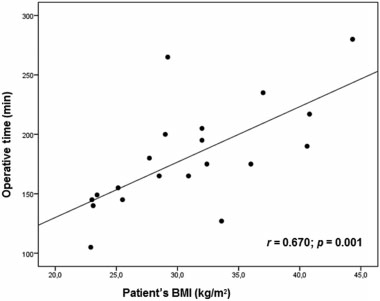
Summary
Revista Brasileira de Ginecologia e Obstetrícia. 2001;23(7):451-455
DOI 10.1590/S0100-72032001000700007
Purpose: to evaluate clinical findings, diagnosis and prognosis of three recent hypercalcemic small cell ovarian carcinoma (HSCC) cases treated in our institution. Methods: information concerning epidemiological data and clinical evolution was obtained from the medical record review. Diagnosis was confirmed through histologic evaluation by our Pathology Department. Results: patients were, at diagnosis, 26, 36 and 38 years old. Tumor diameter ranged from 8.8 cm to 23 cm (mean = 14 cm). All patients presented hypercalcemia with total calcium serum levels of 8.9, 10.8 and 16.7 mEq/dL (NV = 8.8 to 10.2) and ionic calcium levels of 1.26, 1.27 and 1.21 mEq/dL respectively (NV = 1.12 to 1.23). All three patients were submitted to surgical treatment and chemotherapy with platinum-based regimens. In two patients the chemotherapy was adjuvant to the primary surgical treatment. Both are alive and disease-free after 2 and 18 months of follow-up. The other patient had initially the diagnosis of granulosa cell tumor, receiving chemotherapy only after tumor recurrence. Now she is alive with tumor 32 months after diagnosis. Conclusion: the main prognostic factors, in the literature and our experience, are the tumor stage at diagnosis, patient's age, presence of hypercalcemia, large cells, tumor diameter, type of surgical treatment and delay of definitive therapy. The ideal treatment of the hypercalcemic small cell ovarian carcinoma remains unknown. Difficulties in determining a standard therapeutic strategy include rarity of the neoplasm, frequently inadequate initial staging, difficulties in histologic diagnosis and multiple therapeutic approaches.
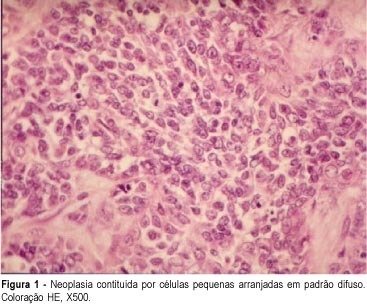
Summary
Revista Brasileira de Ginecologia e Obstetrícia. 2021;43(6):452-456
The objective of the present study was to determine the frequency of malformations and chromosomal abnormalities in a population of fetuses with an aberrant right subclavian artery (ARSA).
This is a 6-year retrospective study of fetuses with a prenatal diagnosis of ARSA conducted during the period between September 2013 and June 2019 at a fetal medicine unit. Data were collected from ultrasound, fetal echocardiograms, genetic studies, and neonatal records.
An ARSA was diagnosed in 22 fetuses. An ARSA was an isolated finding in 18 out of 22 cases (82%). Associated abnormal sonographic findings were found in 4 cases. All cases underwent invasive testing. In 1 of the cases, a chromosomal abnormality was detected (mos 45,X [13]/46,X,e(X) (p22.1q22.1)). No cases of congenital heart disease were found in any of these fetuses. There were two cases in which the postnatal evaluation revealed amalformation: one case of hypospadias and 1 case of cleft palate.
The presence of an isolated ARSA is benign and is not associated with chromosomal abnormalities. The finding of ARSA, however, warrants a detailed fetal ultrasound in order to exclude major fetal abnormalities and other soft markers.
